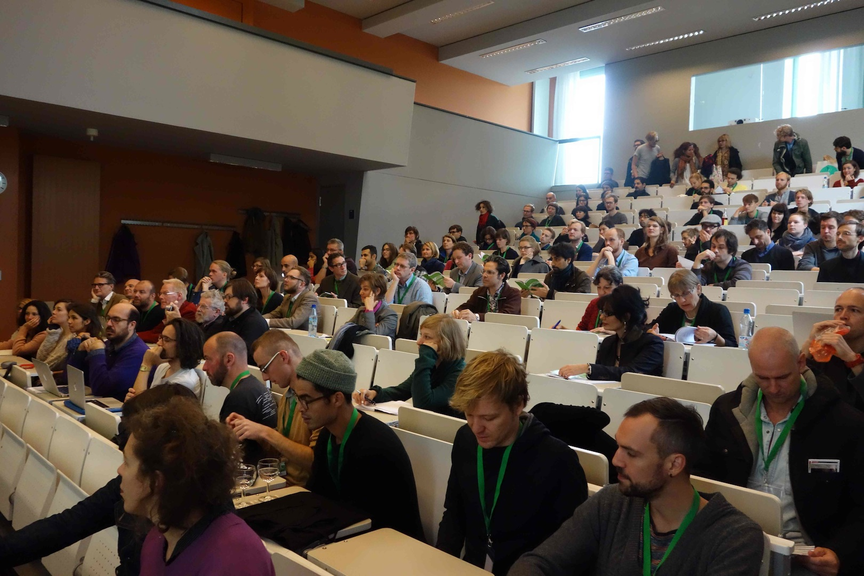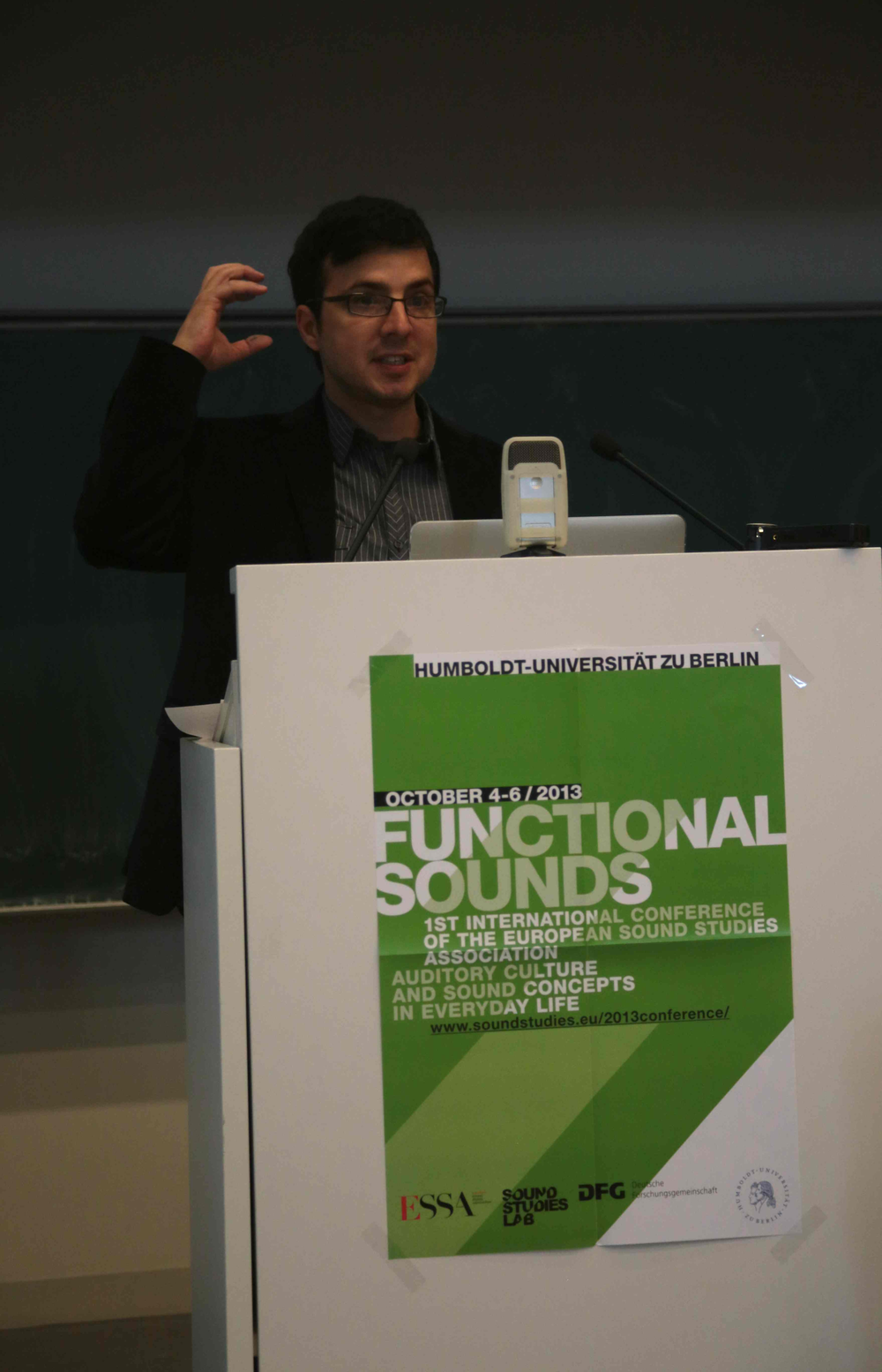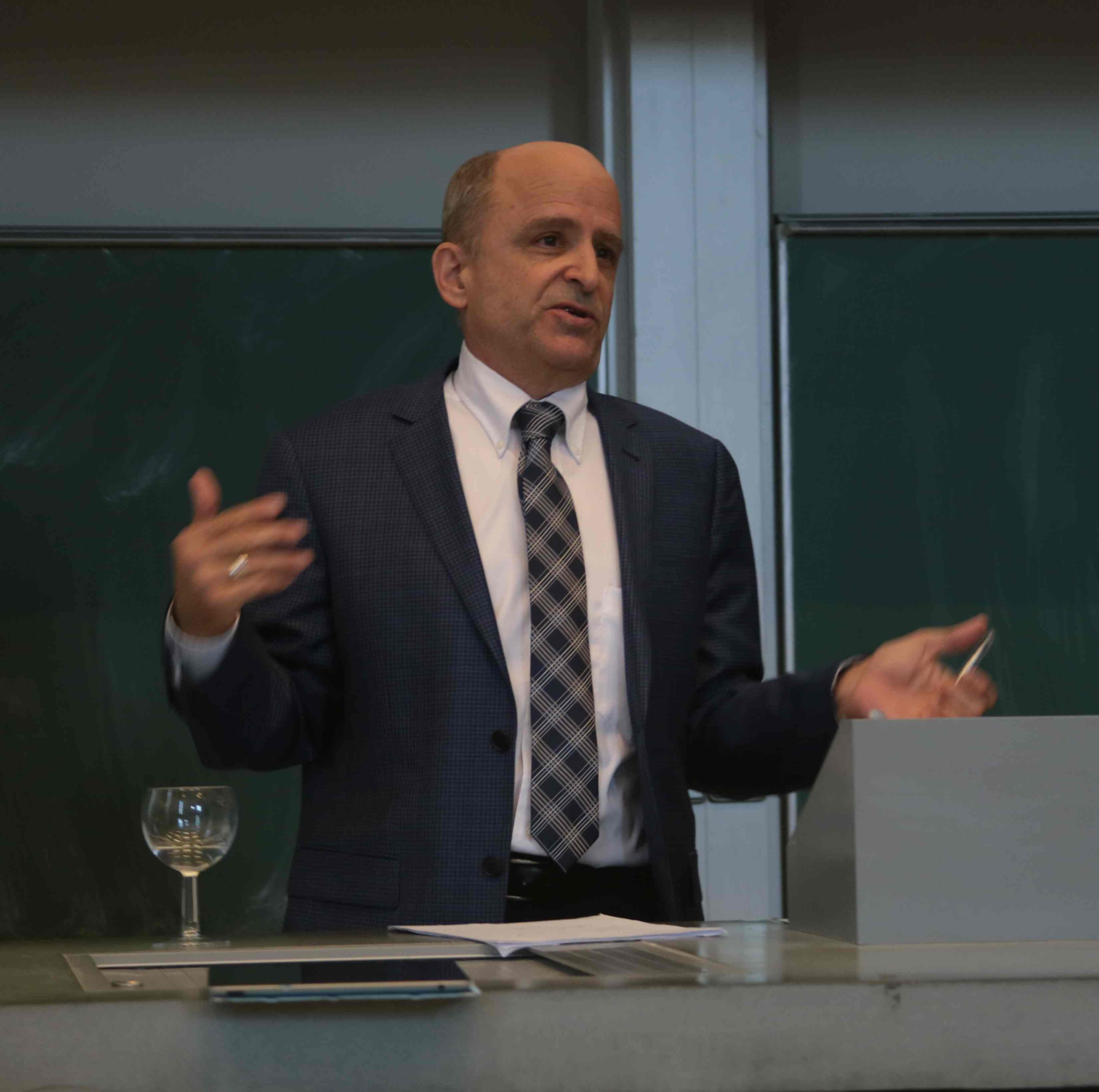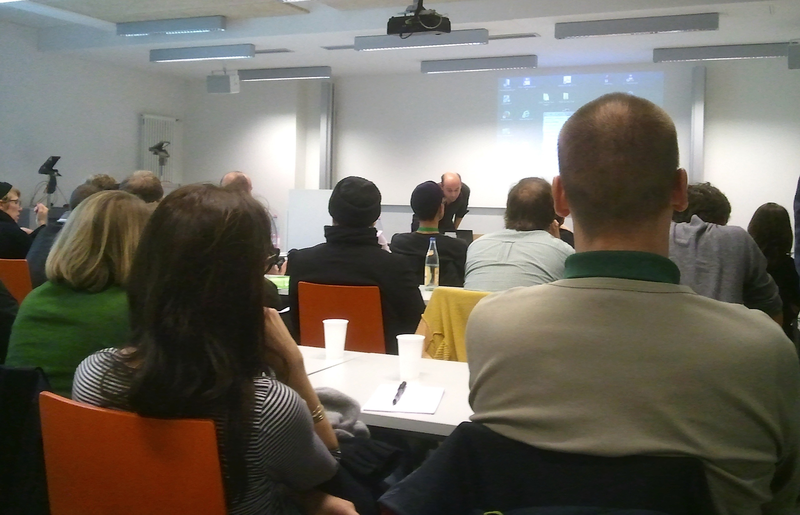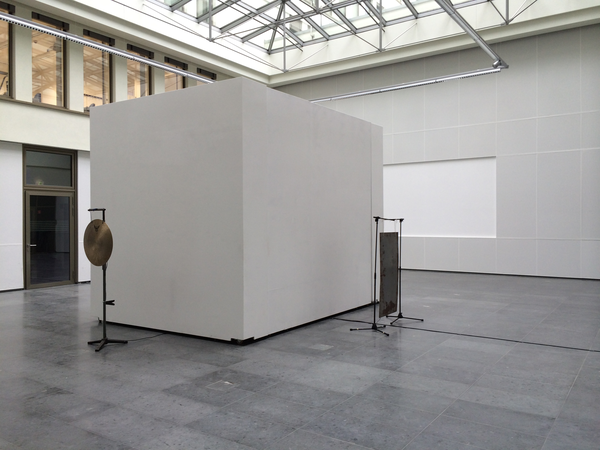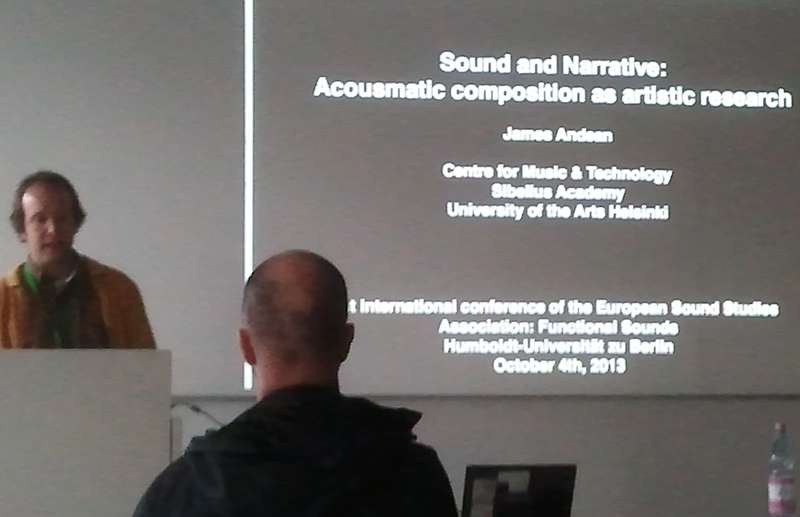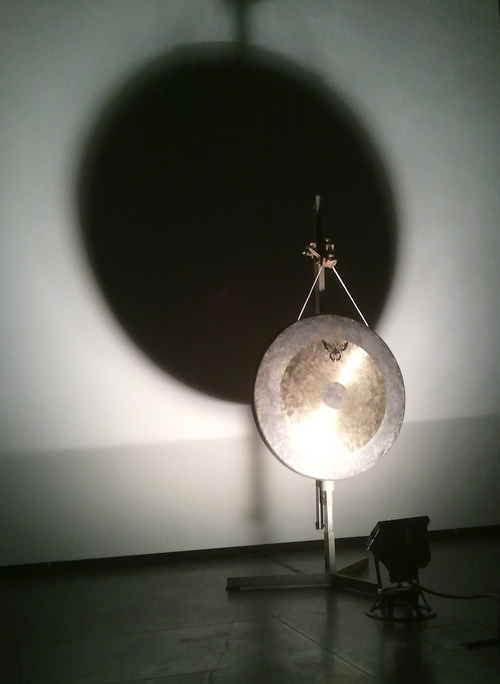Editorial - Functional Sounds in Sound Art and Popular Culture: Proceedings of the First International ESSA Conference 2013, Part I
Julia Krause, Holger Schulze and Marcel Cobussen
ESSA
ESSA, the European Sound Studies Association, was officially founded in June 2012 by Michael Bull (UK), Marcel Cobussen (NL), Erik Granly Jensen (DK; founding vice-chair), Anahid Kassabian (UK/US), Jacob Kreutzfeld (DK; founding vice-chair), Tellef Kvifte (N), Ansa Lønstrup (DK), Morten Michelsen (DK; founding chair), Holger Schulze (D; founding vice-chair), and Heikki Uimonen (SF).
ESSA has come into existence as a response to the tremendous growth in sound studies in diverse research cultures all over Europe and worldwide. An interdisciplinary and international group of researchers – connected by various research networks, conferences, and workshops all over Europe – has initiated this international organization with the aim of bringing together sound researchers and sound artists of all kinds. Its aim is to provide an international, interdisciplinary, and interprofessional organization for promoting the study of sound in conferences, summer schools, workshops, and research projects.
Functions of ESSA include:
- providing a forum where those involved in the study of sound can meet and exchange information about their work
- organizing regular conferences
- disseminating information about sound studies on the association’s web pages and through its mailing list
- encouraging the development of research and systematic study in topics and in areas where such study is not well developed
- encouraging recognition of sound as an area for scholarly research
- providing information on sound sources and resources and encouraging their development.
By May 2014 ESSA was happy to have welcomed over 650 members: young scholars, experienced researchers, independent researchers and PhD-students, designers and artists, musicians, bloggers, and journalists.
The Sound Studies Lab
Host and organizer of the conference was the Sound Studies Lab, founded by Holger Schulze in 2011 at the Humboldt-University in Berlin and funded by the German Research Foundation, the DFG. The initial research questions of the Sound Studies Lab were how human beings experience mediated, non-verbal auditory signs, so-called functional sounds, and how a design theory of auditory signs can be described in terms of a cultural theory. Researchers Carla Müller-Schulzke, Max Schneider, and Julia Krause worked on various aspects of these questions: critical analysis of sound theories from the history of semiotics; field research at the offices of sound designers who invent functional sounds; and analysis of field research in specific listening environments, e.g. in public transport, in public places, in co-working spaces, in the living room.
The more time they spent listening to functional sounds, both historical and extant, and the more they dived into the various, mostly tentative and timid efforts to theorize those rather non-musical and non-verbal sounds, the more they realized that as tiny as the sound objects of their research were, as big was the whole field of functional sounds enveloping human beings, and as rarely was substantial and daring research published on these matters.
The First ESSA Conference
In October 2013 the Sound Studies Lab hosted and organized the first international conference of ESSA at the Humboldt-University, entitled Functional Sounds: Auditory Culture and Sound Concepts in Everyday Life. The conference was co-funded by the German Research Foundation, the DFG. Keynote speakers were Jason Stanyek from the University of Oxford and Douglas Kahn from the University of New South Wales.
Stanyek’s talk concentrated on the long history of active noise control, “canceling” specific portions of proximate sound fields through the introduction of electronically generated, inverted-phase “anti-sounds.” Stanyek touched on a series of theories, technologies, processes, and practices crucial to scholars of sonic digitality and functional sounds, specifically on the implications of sonic functionality for a politics of the audible.
In a way, Kahn’s speech also concentrated on the reduction of noise in order to improve communications. With the advent of modern telecommunication technologies in the nineteenth century, noise co-existed with conversation and information exchanges. Many of these noises were considered to be interferences. According to Kahn, a progressive silencing of these sounds has engendered a belief that communication technologies are for communication alone. Kahn’s contribution consisted of presenting some sonic breaches into this ideal.
The conference contained 60 presentations on how the functionality of sounds could be researched and conceptualized. These 60 presentations were divided into 6 streams: (1) Methodologies of Sound, (2) Cultural Politics and Sonic Experience, (3) Sonic Artistic Practices and Research, (4) Sound Design Practices, (5) Soundscapes of the Urban Future, (6) Pop and Sound. The 7 essays selected in this JSS issue are related to presentations from streams 1, 3, and 6, while a paper presented in stream 4 has already been published in JSS6, a special issue on sound design.
Exploring the Functionality of Sounds
But what exactly is this notorious functionality, which stood at the core of this conference? If absolutely anything not merely aesthetic can be called functional, then almost every single moment of and every single action in our lives seems to fall under the spell of functionality. What is it like to live in such “functional times” sonically? When you turned on your computer to read this editorial, you had to listen to disjointed system sounds, startup chimes, alert noises and auditory warning signals, perhaps accompanied by your favorite music in the background or on your headphones. This morning, when entering your office building, you perhaps involuntarily set off the security alarm, causing the guards to quickly materialize, looking as if they would beat you up if you did not instantly produce your electronic identification card. As you made a cup of coffee in the kitchen at work or at home, the automated (or humanly operated) coffee machine emanated a wide range of hissing, beeping and crumbling noises, and while drinking, you perhaps read a newspaper article detailing sound torture. Later, when you entered a subway station, sounds announced almost any execution of the system’s movement and transitory operations, together with sounds from phones and game consoles. In bed at night you could not sleep due to the annoying sounds coming from the traffic outside.
What and how do people think about their sonic environment, about those (daily) sounds that together create their sonic habitat? And how do they verbalize it? In what ways do functional sounds create and monitor borders, and how do they ignore and transgress borders? How do they afford, how do they inhibit? Functional sounds organize and regulate life, but they also avoid regulation. On various (sub)(un)conscious levels, they form, inform, deform, and transform everyday life for individuals and groups. They (re)present and create sexes, genders, ethnicities, and other categories of humans. Everyday auditory cultures can be regarded as semiotically coherent cultures, but they seem to work equally well as large series or bundles of non-related signs. Sounds can heal as well as cause illness (tinnitus, nervous breakdowns, etc.). They can be used to sooth, to energize, to distract from pain, or to create a sense of connectedness. They can be used as a weapon, a means of torture, a nuisance, or a tool of oppression.
In order to investigate these issues and questions, the conference organizers hosted academics, scholars, and designers as well as artists, with the latter especially concentrating on the aesthetic and sensorial explorations of functional sounds through artistic research: How can those bleeps and clicks in our everyday lives be perceived? What is the sensorial impact of each tiny functional pinch? How can the whole of a functional soundscape in an urban environment be understood and what aesthetic interventions are possible?
There was one major performance at this conference that explored this last question in a stunning way. Composers and instrumentalists Sam Auinger and Hannes Strobl – who work for two decades now under the alias of tamtam – performed their hearing perspective regarding functional sounds in three cities: Shanghai, Innsbruck, and Berlin. In their performance they, with great subtlety, created a sonic environment which allowed the audience to experience an urban soundscape in a specific location at a specific time of the day. tamtam presented a compositional and improvisational sensibility which set an inspirational tone for experiencing urban signal environments. Strobl and Auinger’s artistic strategy or sonic thinking-through-sounds generated an immersive situation, inviting listeners to sink into the soundscapes of the aforementioned cities.
The JSS (guest) editors regard this artistic research into the functional sounds of Shanghai as an example of sonic epistemology: Auinger and Strobl musically (re)produce the sonic materialism present in this Asian city; and with their listening perspective, they provide a gateway to the sonic materiality of functional sounds in this urban agglomeration, even, or perhaps especially, if one has never before been in Shanghai.
Contents of this JSS Issue
For this special JSS issue, the (guest) editors selected seven articles exploring a wide variety of aspects concerning functionality in the realm of the sonic. The articles present examples from the fields of popular culture and sound art that might help us understand how technical dispositives, aesthetic practices, and specific sonic artefacts engage with the requirements of functionality. This JSS issue thus presents a sampling of research and/or art which incorporates and/or analyzes the intense aspects of noise, loudness, violence, volume, sound, and its materialism on the one side, and silence, quietness, tenderness, reduction, narrativity, and the dematerialization of sound on the other. Another aspect linking these seven papers together is the general question of how functional sounds take us back to the most basic, most situative and corporeal ideas about how sound affects a listener. Functional sounds might therefore not be disregarded as peripheral or marginal, but should be at the core of everyday listening experiences.
Under the title of The Exceptional Purity of Sound, Melle Jan Kromhout from the University of Amsterdam takes us into the history of and the technological developments accompanying the (almost) inevitable background and recording/storage media noise in sound recordings: “Information theory itself undercuts the clear difference between signal and noise. No matter how desperately noise reduction claims it cunningly reduces a clearly defined object and produces a supposed clean ‘original,’ this object is always only negatively defined by what it is not.” How can we understand this process of domesticating noise (Sterne)?
Mark Nazemi from the Simon Fraser University in Vancouver, legendary institution hosting the World Soundscape Project during its beginnings, presents with Affective Soundscape Composition for evoking Sonic Immersion his findings concerning a dedicated effort toward making the artistic practice of soundscape composition functional for medical and therapeutic issues: “There remains consideration of the potentiality of using deep listening techniques, specifically recordings of mediated spaces, as a tool for analgesic purposes […] this novel approach is one of the first attempts at improving the psychological experience of patients in clinics by immersing them in a sonic milieu.”
As another example of artistic research, James Andean from the Sibelius Academy in Helsinki explores, with his paper Sound and Narrative, the functional aspects of an acousmatic composition. What narrative cues and guidelines does (or even must) an acousmatic composition provide, sometimes unwillingly so? “The encounter of work and independent listener is […] often an extremely informative moment with regards to the nature of the work, and without this perspective, any consideration of the narrative aspects of a work are severely limited by the composers narrowed field of focus […]. This can be quite an alarming moment, as the composer witnesses the transformation of the work he intended into a potentially very different artwork.”
Olivia Lucas from Harvard University explores the band Sunn O)))’s technoaesthetics of pure volume under the title MAXIMIUM VOLUME YIELDS MAXIMUM RESULTS: an appropriation of Sunn O)))’s constant advice on their tech riders for the sound engineers at performance venues. “The insistence on sub-bass frequencies forces the audience to feel with their bodies what is being done to their ears. Sunn O))) is coercive synesthesia, as low frequencies are magnified into physical entities. The main content of a Sunn O))) concert is 120 dB of sound emerging from dense fog.”
Neil Verma from the University of Chicago allows us to take part in a radiophonic exploration within A Paleontology of Quiet. He provides an unconventional interpretation of the classic America radio drama The Thing on the Fourble Board, a play by writer Wyllis Cooper, referring to current discussions in sound studies: “The question is no longer how to get critical tools to help ‘think sound,’ but how to sort among them in a manner that reflects what is perhaps the core insight of recent sound scholarship, that sound requires methods, but it also precedes method and is a method.”
Jeremy Woodruff presented his sound artwork Gongburgh: Steeltown Forests at the conference.
His article Remaking Pittsburgh: Permaculture Soundscapes gives an insight into the aesthetic approach underlying his sound work. Might a sensory aesthetic of permaculture be a truly functional and inspiring approach to the rather apocalyptic developments concerning climate change and upcoming wars for basic resources? “Gongburgh: Steeltown Forests is a prayer for Pittsburgh and for the US in general, a vision of how revived cities like Pittsburgh could once again be remade, in the sound-image of a garden instead of an (in Pittsburgh, pharmaceutical) industry; through cooperatives rather than venture capital; through personal and local relationships rather than relentless upward mobility. If I could remake Pittsburgh, the university there (as well as universities all over the US) would allow members of the public not even enrolled at the university to join the gamelan. The gamelan would play regularly to help grow participation and culture at urban garden projects like the Hazelwood Food Forest and aid other grassroots efforts.”
Music Dematerialized? is the question Francisco López tries to answer. In his article he argues how the disappearance of the object in recorded commercial music can be understood as part of a cultural history: “The ‘broadcasting/streaming’ dematerialization (both analog and digital; from classic radio to piped Muzak to online/’cloud’ streaming) can be seen as a further degree of dematerialized ownership or accessibility. We do not even have the encoded information - whether analog or digital - but instead have (own, buy, get granted) the right to access it as a decoded physical perceptive manifestation (audible sound in the case of music).”
By bringing together various approaches, methodologies, research idioms, and research objects, this special JSS issue perhaps opens up the field of functional sounds in a rather surprising way: the various perspectives provide an approach to functionality which exceeds any framework of highly pragmatic effectivity; functionality, as it is presented here, seems to be a strong reminder of the basic (sonic) materiality present in any given situation. From such a hearing perspective, the use of and reference to functional sounds is actually a form of enhanced presence in listening, in sounding, in sensing.

